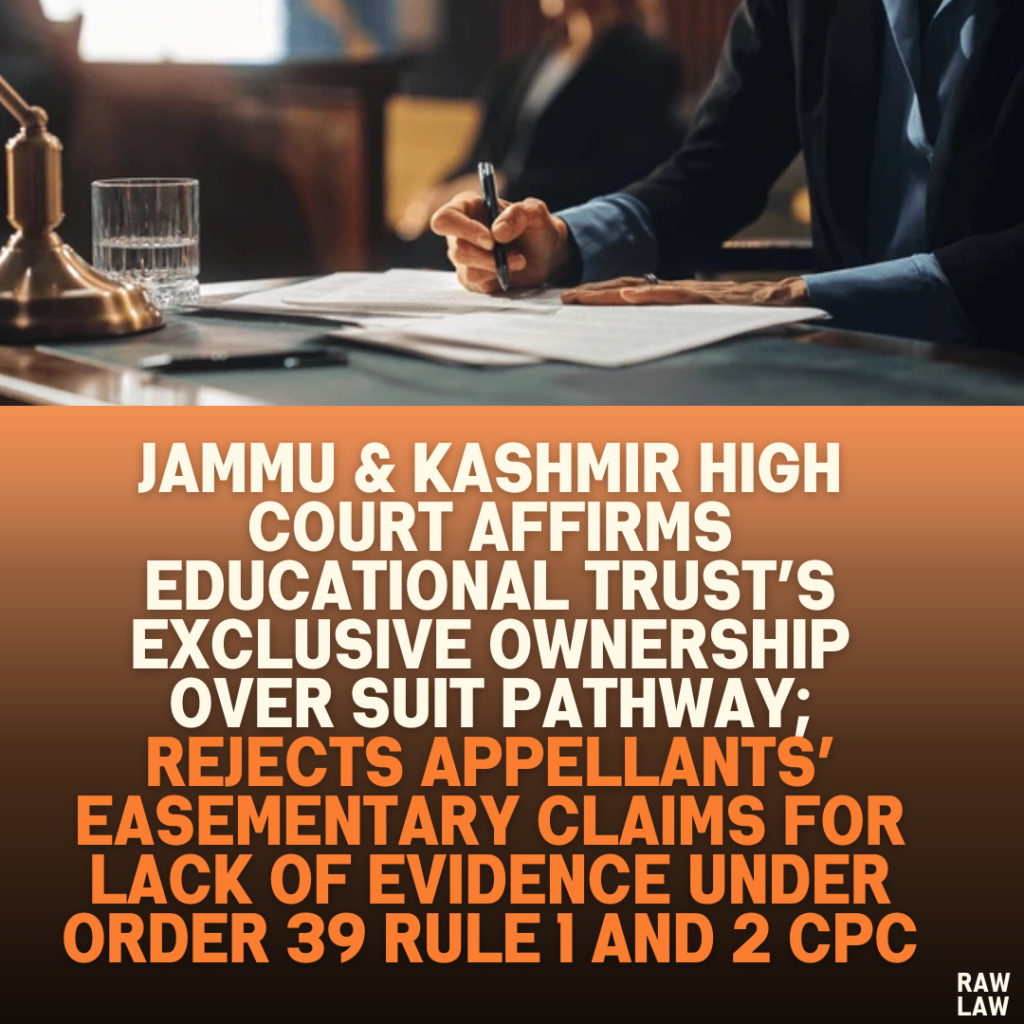Court’s Decision
The Jammu & Kashmir High Court dismissed the appeal filed by the appellants, affirming the trial court’s order under Order 39 Rule 1 and 2 of the Code of Civil Procedure (CPC). The court held that the plaintiff had established a prima facie case of exclusive ownership over the suit pathway, rejecting the appellants’ claims of easementary rights due to lack of evidence.
Facts
The plaintiff, an educational trust, filed a civil suit against the appellants seeking:
- A mandatory injunction to prevent the appellants from interfering with the pathway leading to their educational institution.
- A prohibitory injunction to ensure the defendants did not encroach upon or damage the property.
The property in question, located in Lethpora, Pulwama, included a pathway measuring 14×788 feet, which the plaintiff claimed was acquired via a registered sale deed. This pathway provided access to the educational institution run by the trust.
The plaintiff cited safety concerns for their predominantly female student body, asserting that local inhabitants were trespassing, damaging the property, and misusing it. The plaintiff sought protection to safeguard the institution’s operations and security.
The appellants contended that:
- The pathway was their sole means of access to their residential houses.
- They had been using it for decades, thereby acquiring easementary rights over it.
- The sale deed executed in favor of the plaintiff was fraudulent and had unlawfully included the pathway, depriving them of their rightful access.
Issues
- Does the plaintiff have exclusive ownership of the suit pathway?
- Have the appellants acquired easementary rights over the pathway due to prolonged usage?
- Did the trial court err in granting the injunction in favor of the plaintiff without verifying the ground realities?
Petitioner’s Arguments (Plaintiff)
- Ownership Established: The plaintiff argued that the pathway was purchased via a valid registered sale deed dated 12.07.2011. This was corroborated by revenue records and a certificate from the local Tehsildar.
- Security Concerns: The pathway was essential for the safety of the institution’s students and staff, particularly female students.
- Trespassing and Damage: The appellants were unlawfully obstructing and vandalizing the pathway, prompting the plaintiff to erect a gate for security purposes.
- Lack of Appellants’ Rights: The appellants had no legal claim to the pathway, as it was private property exclusively owned by the trust.
Respondent’s Arguments (Appellants)
- Easementary Rights: The appellants claimed the pathway was the only access to their residences and had been used for decades, establishing their easementary rights under the Indian Easements Act, 1882.
- Sale Deed Disputed: The appellants contended that the sale deed executed in favor of the plaintiff was invalid and incorporated misleading clauses to claim ownership over the pathway.
- Erroneous Trial Court Order: The appellants argued that the trial court failed to appoint a commissioner to ascertain the ground realities and instead relied solely on documentary evidence submitted by the plaintiff.
Analysis of the Law
- Order 39 Rule 1 and 2 CPC: The court emphasized that granting an interim injunction requires establishing:
- A prima facie case in favor of the applicant.
- The balance of convenience tilting towards the applicant.
- The likelihood of irreparable harm if the injunction is not granted.
The plaintiff successfully demonstrated ownership through documentary evidence, including:
- The registered sale deed for the pathway.
- Certificates from the Tehsildar validating ownership and exclusive access.
- A site map confirming an alternate ingress and egress to the appellants’ residences.
The court found that the appellants failed to produce evidence of:
- Continuous usage of the pathway to establish easementary rights.
- Lack of alternative access to their residences.
The court held that appointing a commissioner was unnecessary since the plaintiff’s documentary evidence was sufficient to establish the ownership of the pathway.
Precedent Analysis
The appellants cited Joy Auto Works v. Sumer Builders (2009) 4 SCC 691, where the Supreme Court emphasized protecting access rights in the absence of alternative pathways. However, the court distinguished the present case, noting that:
- In Joy Auto Works, the appellants proved the absence of alternative access.
- Here, the appellants failed to substantiate their claim that the pathway was their only means of ingress and egress.
Court’s Reasoning
- Prima Facie Case: The court found overwhelming evidence supporting the plaintiff’s ownership, including official documents and the sale deed.
- Failure to Prove Easementary Rights: The appellants could not demonstrate prolonged and exclusive use of the pathway or the absence of alternatives.
- Sufficiency of Documentary Evidence: The court ruled that the trial court’s reliance on documentary evidence was reasonable, negating the need for appointing a commissioner.
- Limited Appellate Interference: The court reiterated that appellate interference in discretionary orders under Order 39 Rule 1 and 2 CPC is permissible only in cases of arbitrariness or perversity, neither of which was present here.
Conclusion
The appeal was dismissed. The court upheld the trial court’s injunction, confirming the plaintiff’s exclusive ownership of the suit pathway. The appellants’ claims of easementary rights were rejected due to lack of evidence.
Implications
- Property Rights: The judgment reinforces the sanctity of documented property ownership and limits challenges based on unsubstantiated claims.
- Easementary Rights: The case clarifies the evidentiary burden required to establish easementary rights under the Indian Easements Act, 1882.
- Judicial Discretion: The judgment underscores the limited scope of appellate courts in interfering with discretionary interim orders under Order 39 Rule 1 and 2 CPC.
This judgment provides a significant precedent in property disputes involving conflicts between documented ownership and easement claims.
